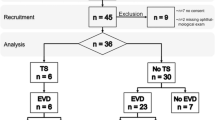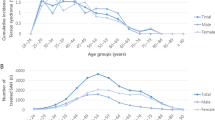Abstract
This prospective trial was designed to evaluate the incidence of Terson syndrome in patients suffering from subarachnoid hemorrhage, intracerebral hemorrhage, or traumatic brain injury and whether consequences necessarily derive from the intraocular hemorrhage itself. Two ophthalmologic examinations were performed to identify patients with Terson syndrome. Data on initial Glasgow Coma Scale, Hunt and Hess and Fisher grades, aneurysm site and diameter, and volume of hemorrhage in intracerebral hemorrhage patients were correlated to the location and course of Terson syndrome. Follow-up was performed after 3 months, including clinical and ophthalmologic investigations. The data showed that 16 of 83 subarachnoid hemorrhage patients (19.3 %), 2 of 22 intracerebral hemorrhage patients (9.1 %), and 1 of 32 traumatic brain injury patients (3.1 %) suffered from Terson syndrome. Low Glasgow Coma Scale (p = 0.002), high Hunt and Hess grade (p < 0.001), and high Fisher grade (p = 0.002) were found to be associated with a higher incidence of Terson syndrome. The neurological outcome in subarachnoid hemorrhage patients suffering from Terson syndrome was worse compared with that of subarachnoid hemorrhage patients without Terson syndrome (p = 0.005), and vitrectomy was performed in seven eyes of six patients due to poor visual acuity. Terson syndrome is underestimated in patients with subarachnoid hemorrhage and a rare pathology in intracerebral hemorrhage as well as in traumatic brain injury patients. Spontaneous regression of the intraocular hemorrhage may be seen, but in half of the patients, vitrectomy is necessary to prevent permanent visual deterioration.




Similar content being viewed by others
References
Arakawa Y, Goto Y, Ishii A, Ueno Y, Kikuta K, Yoshizumi H et al (2000) Terson syndrome caused by ventricular hemorrhage associated with moyamoya disease. Neurol Med Chir (Tokyo) 40:480–483
Augsten R, Konigsdorffer E (2007) Terson syndrome—a contribution to the timing of operation for pars plana vitrectomy. Klin Monbl Augenheilkd 224:674–677, German
Baker ML, Hand PJ, Tange D (2008) Terson’s syndrome in spontaneous spinal subarachnoid haemorrhage. J Clin Neurosci 15:313–316
Castren JA (1963) Pathogenesis and treatment of Terson-syndrome. Acta Ophthalmol 41:430–434
Fahmy JA (1973) Fundal haemorrhages in ruptured intracranial aneurysms I. Material, frequency and morphology. Acta Ophthalmol (Copenh) 51:289–298
Fountas KN, Kapsalaki EZ, Lee GP, Machinis TG, Grigorian AA, Robinson JS et al (2008) Terson hemorrhage in patients suffering aneurysmal subarachnoid hemorrhage: predisposing factors and prognostic significance. J Neurosurg 109:439–444
Frizzel RT, Kuhn F, Morris R, Quinn C, Fisher WS III (1997) Screening for ocular hemorrhages in patients with ruptured cerebral aneurysms: a prospective study of 99 patients. Neurosurgery 41:529–533, Discussion 33–34
Garfinkle AM, Danys IR, Nicolle DA, Colohan AR, Brem S (1992) Terson’s syndrome: a reversible cause of blindness following subarachnoid hemorrhage. J Neurosurg 76:766–771
Gauntt CD, Sherry RG, Kannan C (2007) Terson syndrome with bilateral optic nerve sheath hemorrhage. J Neuroophthalmol 27(3):193–194
Gibran S, Mirza K, Kinsella F (2002) Unilateral vitreous haemorrhage secondary to caudal epidural injection: a variant of Terson’s syndrome. Br J Ophthalmol 86:353–354
Hegdes TR Jr, Walsh FB (1955) Optic nerve sheath and subhyaloid hemorrhage as a complication of angiocardiography. AMA Arch Ophthalmol 54:425–427
Hoving EW, Rahmani M, Los LI, Renardel de Lavalette VW (2009) Bilateral retinal hemorrhage after endoscopic third ventriculostomy: iatrogenic Terson syndrome. J Neurosurg 100:858–860
Kim HS, Lee SW, Sung SK, Seo EK (2012) Terson syndrome caused by intraventricular hemorrhage associated with moyamoya disease. J Korean Neurosurg Soc 51:367–369
Kuhn F, Morris R, Witherspoon CD, Mester V (1998) Terson syndrome, results of vitrectomy and the significance of vitreous hemorrhage in patients with subarachnoid hemorrhage. Ophthalmology 105:472–477
Litten M (1881) Ueber Einige von Allgemein-Klinischen Standpunkt aus Interessante Augenveränderungen. Berl Klin Wochenschr 18:23–27, German
Manschot WA (1954) Subarachnoid hemorrhage. Intraocular symptoms and their pathogenesis. Am J Ophthalmol 38:501–505
Medele RJ, Stummer W, Mueller AJ, Steiger HJ, Reulen HJ (1998) Terson’s syndrome in subarachnoid hemorrhage and severe brain injury accompanied by acutely raised intracranial pressure. J Neurosurg 88:851–854
Mena OJ, Paul I, Reichard RR (2011) Ocular findings in raised intracranial pressure: a case of Terson syndrome in a 7-month-old infant. Am J Forensic Med Pathol 32:55–57
Muller PJ, Deck JH (1974) Intraocular and optic nerve sheath hemorrhage in cases of sudden intracranial hypertension. J Neurosurg 41:160–166
Naseri A, Blumenkranz MS, Horton JC (2001) Terson’s syndrome following epidural saline injection. Neurology 57:364
Ogawa T, Kitaoka T, Dake Y, Amemiya T (2001) Terson syndrome. A case report suggesting the mechanism of vitreous hemorrhage. Ophthalmology 108:1654–1656
Pfausler B, Belcl R, Metzler R, Mohsenipour I, Schmutzhard E (1996) Terson’s syndrome in spontaneous subarachnoid hemorrhage: a prospective study in 60 consecutive patients. J Neurosurg 85:392–394
Shaw HE Jr, Landers MB III (1975) Vitreous hemorrhage after intracranial hemorrhage. Am J Ophthalmol 80:207–213
Shaw HE Jr, Landers MB III, Syndor CF (1977) The significance of intraocular hemorrhages due to subarachnoid hemorrhage. An Ophthalmol 9:1403–1405
Stiebel-Kalish H, Turtel LS, Kupersmith MJ (2004) The natural history of nontraumatic subarachnoid hemorrhage-related intraocular hemorrhages. Retina 24:36–40
Stienen MN, Lücke S, Gautschi OP, Harders A (2012) Terson hemorrhage in patients suffering aneurysmal subarachnoid hemorrhage: a prospective analysis of 60 consecutive patients. Clin Neurol Neurosurg 114:535–538
Sung W, Arnaldo B, Sergio C, Juliana S, Michel F (2011) Terson’s syndrome as a prognostic factor for mortality of spontaneous subarachnoid haemorrhage. Acta Ophthalmol 89:544–547
Swallow CE, Tsuruda JS, Digre KB, Glaser MJ, Davidson HC, Harnsberger HR (1998) Terson syndrome: CT evaluation in 12 patients. AJNR Am J Neuroradiol 19:743–747
Takkar A, Kesav P, Lal V, Gupta A (2013) Terson syndrome in cortical venous sinus thrombosis. Neurology 81:e40–e41
Terson A (1900) De ĺhemorrhagie dans le corps vitre au cours de ĺhemorrhagie cerebrale. Clin Ophthalmol 6:309–312
Toosi SH, Malton M (1987) Terson’s syndrome-significance of ocular findings. Ann Ophthalmol 19:7–12
Vanderlinden RG, Chisholm LD (1974) Vitreous hemorrhages and sudden increased intracranial pressure. J Neurosurg 41:167–176
Walsh FB, Hedges TR (1951) Optic nerve sheath hemorrhage. Am J Ophthalmol 34:509–527
Weaver RG, Davis CH (1961) Subhyaloid hemorrhage. Am J Ophthalmol 52:257–259
Wietholter S, Steube D, Stotz HP (1998) Terson syndrome: a frequently missed opthalmologic complication in subarachnoid hemorrhage. Zentralbl Neurochir 59:166–170
Acknowledgments
The authors thank the nursing staff and ward physicians in the department of intensive care at our medical center for their patience and support of the study. We also would like to express our deep gratitude to all enrolled patients and their legal representatives for making this study possible.
Authors’ contributions
PC, VK, and JR conceived and designed the study. PC, CS, VK, and LW acquired the data. PC, CS, EV, and LW analyzed and interpreted the data. PC, GR, LW, MW, and JR revised the article critically for important intellectual content. PC, CS, MW, and JR gave the final approval of the version to be published.
Conflict of interest
The authors have no personal financial interest in any of the materials or devices described in this article.
Ethical standards
The study was approved by the ethics committee of the medical council of the state of Hamburg and has been performed in accordance with the ethical standards laid down in the 1964 Declaration of Helsinki and its later amendments. Written consent was obtained by each patient or their legal representative prior to any ophthalmologic examination.
Author information
Authors and Affiliations
Corresponding author
Additional information
Comments
Konstantinos N. Fountas, Larisa, Greece
The presence of blood in the vitreous body of the orbit is known as Terson hemorrhage. This pathological condition was firstly described in 1881, by Moritz Litten, a German physician [1]. However, this clinico-pathological entity was described in detail and reported in the literature by Albert Terson in a monograph, in 1900 [2]. Since that initial report, numerous publications have outlined the various anatomical locations of intraocular hemorrhages, which may be preretinal, retinal, subretinal, hyaloidal, subhyaloidal, and/or intra-vitreous, and have clearly defined its strong association with a sudden increase of the intracranial pressure. Thus, Terson hemorrhages have been reported to be present in patients suffering spontaneous or traumatic subarachnoid hemorrhage, severe head injuries, or venous sinus thrombosis.
Although the causative relationship of Terson hemorrhage and aneurysmal subarachnoid hemorrhage (aSAH) has been reported in several recent clinical series, the actual occurrence of Terson hemorrhages among patients with aSAH remains still ill defined. Furthermore, the morbidity associated with Terson hemorrhages is generally underestimated in patients suffering aSAH. Moreover, the prognostic significance of Terson hemorrhage in patients with aSAH has not been adequately explored.
Czorlich et al. [3] in their current, well-designed, prospective study are examining systematically the actual incidence of Terson hemorrhage among patients suffering spontaneous SAH, and SAH of aneurysmal origin. The authors are exploring in their cohort the potential role of the severity and the extent of the initial subarachnoid hemorrhage and also the anatomic location of the ruptured aneurysm in the development of Terson hemorrhages. In addition, they study the prognostic role of Terson hemorrhages in the overall outcome of patients suffering aSAH.
But, Czorlich et al. [3] have not limited their study to SAH patients only. They examine the incidence of Terson hemorrhages in two other groups of neurosurgical patients with special interest: patients suffering from intracranial but subarachnoid hemorrhage and also patients with closed head injuries. They provide an initial approach in the occurrence of Terson hemorrhages in these two extremely common clinico-pathological entities, which definitely require further studying in the near future. Their work may well serve as a stimulus for additional clinical research in this field, and their current data could constitute the basis for better understanding of the underlying pathophysiologic mechanism in Terson hemorrhages.
References
1. Litten M. Ueber Einige vom Allgemein-Klinischen Standpunkt aus Interessante Augenveränderungen. Berl Klin Wochenschr 1881;18: 23–7
2. Terson A. De l’hémorrhagie dans le corps vitre au cours de l’hémorrhagie cerebrale. Clin Ophthalmol 1900;6: 309–12
3. Czorlich P., Skevas C., Knospe V., Vettorazzi E., Gisbert R., Wagenfeld L, et al. Terson syndrome in subarachnoid hemorrhage, intracerebral hemorrhage, and traumatic brain injury. Neurosurg Rev 2014;
Patrick Czorlich and Christos Skevas contributed equally.
Rights and permissions
About this article
Cite this article
Czorlich, P., Skevas, C., Knospe, V. et al. Terson syndrome in subarachnoid hemorrhage, intracerebral hemorrhage, and traumatic brain injury. Neurosurg Rev 38, 129–136 (2015). https://doi.org/10.1007/s10143-014-0564-4
Received:
Revised:
Accepted:
Published:
Issue Date:
DOI: https://doi.org/10.1007/s10143-014-0564-4




